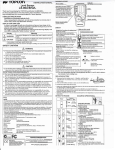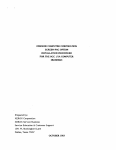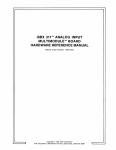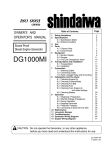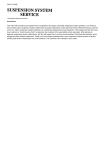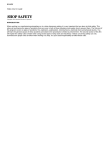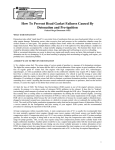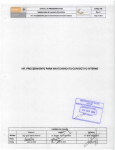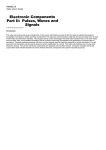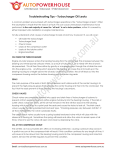Download Video User's Guide
Transcript
Video User's Guide INTRODUCTION This video will summarise and explain the basic operation and construction of an automotive turbocharger. You will learn that turbochargers are now used by almost all automobile and truck manufacturers. You will discover that a “turbo" has the ability to easily increase the horsepower of an engine by fifty percent or more. A turbocharger can also increase engine power under a load and still have little effect on fuel economy at cruising speeds. The first section of this program describes the construction and operating principles of a turbocharger. The second section deals with service procedures associated with a "turbo.” This tape is an important reference regarding turbo-charger operation, design and service. Copyright 1993, Meridian Education Corporation STUDENT OBJECTIVES After viewing this video, the student will be able to: • • • • • • • • • • Explain the function of an automotive turbocharger. Describe the operation of a turbocharger. Define the term nonnal aspiration. Explain the purpose of a turbocharger waste gate valve. Describe the function of a turbocharger's turbine and compressor. Explain how a turbocharger is lubricated. Describe the purpose of turbo bearings. Define the term turbocharger boost pressure. Remove a turbocharger from an engine. Properly service and repair basic turbocharger malfunctions. TO THE INSTRUCTOR This video is designed to be a valuable supplement to your curriculum. Since young people are extremely acclimated to television, it is a natural way to help present important aspects of your subject matter. This video is designed to give a detailed, yet broad coverage of the topic. Most educators agree that it is best to use as many instructional methods as possible. Utilise quality textbooks, workbooks, videos, lectures, demonstrations, overheads, and other methods to present the technical information. This will hold interest and help pupils understand the large amount of information required to succeed in today's complex world. This video is organised into major sections or topics. Each section covers one major segment of the subject. Graphic breaks are given between each section so that you can stop the video for class discussion, demonstrations, to answer questions, or to ask questions. This allows you to only watch a portion of the program each day or to present the complete video, depending on your curriculum requirements. The video is designed to simplify the complex. Concise wording and carefully selected graphics are used to provide maximum learning in minimum time. Close-up shots of components and service procedures are used to make every second of viewing instructional, as if each student was standing right behind you, watching over your shoulder while you were working or giving a demonstration. Computer animation is used to explain difficult to comprehend principles or techniques. These images show how parts work, how they fit together, or how they vary in design. QUIZ ANSWER KEY 1.a 2.c 3.b 4.c 5.b 6.d 7.a 8.d 9.b 10.d 11.c 12.a 13.b 14.c 15.a Use your own judgement to evaluate the definitions, short answer questions and discussion topics. TECHNICAL TERMS Write definitions for the following terms. Use a textbook or review the video if needed. Turbochargers; normal aspiration; combustion chambers; engine exhaust gases; turbocharger centre housing; turbine wheels; turbo boost; turbo-charger bushings; exhaust flange; engine oil pump; engine oil pan; pressure test gauge; snap ring; thrust washer; torque wrench; axial play; in-line four-cylinder engine; atmospheric pressure; sea level; turbine blade; turbocharger compressor; waste gate valve; waste gate diaphragm; intake manifold; sealing rings; turbo shaft; intercooler; exhaust pipe; snap ring pliers; thrust collar; dial indicator; radial play; VIDEO DISCUSSION TOPICS Here are a few topics that might be used for a class discussion: I. What is the purpose of a turbocharger? 2. Why must a turbocharger be properly lubricated? 3. Describe the construction of a turbocharger waste gate. 4. Explain how to remove a turbocharger from an engine. 5. What should you do if major damage is discovered inside a turbocharger? 6. Why is it important to keep parts organised when servicing a turbocharger? 7. Why should you properly clean any rusty components during a turbocharger rebuild? 8. How can you check a turbocharger for binding before reinstalling it on an engine? VIDEO QUIZ Choose the most correct answer after reading the statement: 1. A turbocharger has the ability to easily increase the horsepower of an engine by _________ percent or more. a. fifty b. five c. ten d. twenty 2. Normal ________ means the engine uses atmospheric pressure to cause air to flow into the combustion chambers. a. ignition b. distribution c. aspiration d. vacuum 3. The power to spin the _________ comes from the engine exhaust gases. a. flywheel b. turbocharger c. crankshaft d. converter 4. ___________ is routed into one side of the turbo to spin a turbine blade, then a fan or impeller on the other side of the turbo blows air into the engine under pressure. a. Fuel b. Oil c. Exhaust d. Coolant 5. Two large _________ surround the turbocharger compressor and turbine wheels. a. washers b. housings c. pins d. screws 6. Which of the following limits maximum turbocharger boost pressure? a. The EGR valve b. The throttle sensor c. The LED valve d. The waste gate valve 7. ___________ secure the turbine and compressor wheels to the turbo shaft. a. Nuts b. Rods c. Washers d. Seals (Enlarge this page for classroom use.) VIDEO QUIZ (Continued) 8. The _________ wheel is mounted in the intake manifold side of the turbocharger. a. centre b. exhaust c. turbine d. compressor 9. The turbocharger __________ wheel is rotated by engine exhaust gas flow. a. centre b. turbine c. converter d. compressor 10. The turbo shaft passes through the centre of the _________ housings and connects the turbine and compressor wheels. a. manifold b. engine c. converter d. turbocharger 11. The exhaust manifold ports direct all of the engine's burned gases into the __________ housing. a. converter b. vacuum c. turbine d. LED 12. After oil is forced into the turbo bearings, it then drains into the bottom of the housing and into a tube going to the __________ oil pan. a. engine b. transmission c. converter d. compressor 13. By regulating _________ pressure, the waste gate protects the engine from damage. a. fuel b. boost c. oil d. coolant 14. If you fail to lubricate parts during turbocharger reassembly, __________ damage may occur when first starting the engine. a. transmission b. converter c. turbo d. injector 15. During turbocharger reassembly, never try to force the __________ housing down or you can damage the sealing rings, thrust washers or bearings. a. centre b. manifold c. converter d. pump (Enlarge this page for classroom use.) SHORT ANSWER Briefly answer the following questions in your own words: 1. 2. 3. 4. 5. 6. 7. 8. 9. 10. Name some of the vehicles that are equipped with a turbocharger. Describe the basic operation of a turbocharger. What is the purpose of a waste gate diaphragm? Explain the purpose of turbocharger bearings. What should a visual inspection consist of when checking the condition of an automotive turbocharger? How can a faulty turbocharger affect an engine's performance? What is the function of the turbo shaft sealing rings? Describe the operation of a turbocharger intercooler. Explain how to diagnose turbocharger malfunctions. Why should a "dial indicator" be used during a turbo-charger rebuild? (Enlarge this page for classroom use.) WE NEED YOUR HELP! We are constantly trying to improve our videos. If you have any suggestions or comments, please send them to us with details (title, time code location, etc.) of any potential improvement. We will try to incorporate suggestions when revising our videos. Your help will be greatly appreciated. We want to help you train America's youth! OTHER TIMELY TOPICS on DIESEL ENGINE TECHNOLOGY available from MERIDIAN EDUCATION CORPORAnON • Diesel Engine Reassembly (Item No.5210) • Diesel Engine Operation (Item No.5211) • Diesel Engine Teardown (Item No.5212) • Diesel Head Service (Item No.5213) • Diesel Short Block Service (Item No.5214) • Diesel Injection System Service (Item No.5215) • Turbocharger Service (Item No.5216) • Superchargers (Item No.5217)








